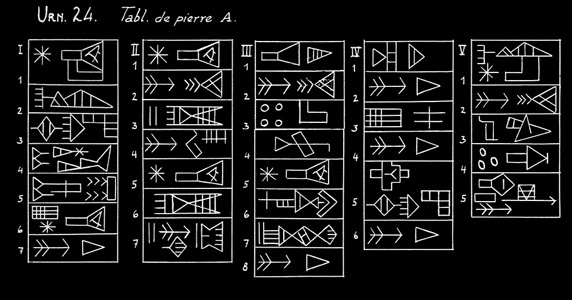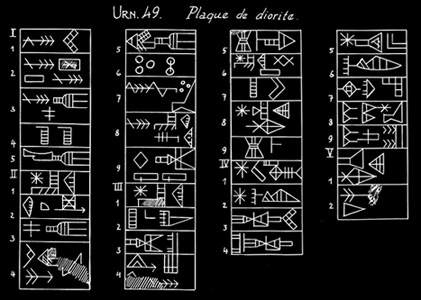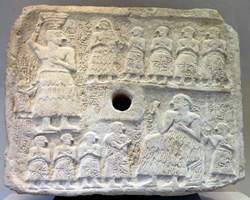|
|
Ur-Nanshe, last Lugal of
the first Dynasty of Lagash
Considering: URN 24
CDLI
LINK
CDLI # P222363

Translation: (Extract from "The Ancient Near East, C. 3000-3300
BC"
- quoting Steible and Behrens 1982: Urn. 24; Cooper 1986 La.
1.17)
"Ur-Nanshe, king of Lagash, son of Gunidu, 'son' of (the town)
Gursar, built the temple
of Nanshe (goddess), fashioned (the statue of) Nanshe, dug the
canal.
. ., For Nanshe he made water fill (the canal). . ., made (a
statue of) Esir.
He chose Ur-nimin by means of liver-omens (as) husband (i.e.
high cultic official) of Nanshe.
He built the A-edin ('house of the desert'), built the Nin-gar,
built the E-gidri (all these are shrines), built the walls of
Lagash fashioned (the statue of) Lugal-uru.
The boats of Dilmun (region of Bahrain), from (this distant)
land brought the wood (for him)."
The Parentage of Ur-Nanshe:
Kramer 1963 [1]:
"A generation or so following Mesalim's reign, 2450 B.C. or
thereabouts, a man named Ur-Nanshe
established himself as king of Lagash and founded a dynasty
which was to endure for generations.
We do not know where Ur-Nanshe came from or how he rose to power
- there is even a bare possibility
that he was originally not a Sumerian but a Semite from a land
known as Tilnum, to the west of Sumer.
Hallo 1981 [2]:
"The title [king of Lagash] was assumed next by Ur-Nanshe, who,
though of nonroyal parentage,
estalished the dynastic principal at Lagash."
King 1910 [3]:
"..we know that he was founder of his dynasty for [neither]
to his father Gunidu, nor to his
grandfather Gursar, does he ascribe a titular rank."
The Inclination and Inscriptions
of Ur-Nanshe:
King 1910:
"It is strange that in none of his numerous inscription does
he lay claim to any conquest or
achievement in the field. Most of his texts, it is true, are
of a dedicatory character, but,
to judge from those other Sumerian rulers, this fact should
not have prevented him from referring
to them, had he any successful chronicle." King observes that
Ur-Nanshe's ambition seems most
clearly to have been in the building and strengthening of Lagash's
defensive systems: "so
long as the fortifications of the city were intact, and the
armed men at her disposal sufficient
for the defense of Lagash herself and her outlying territory,
he did not seek to add to his own
renown or to the city's wealth by foreign conquest... It was
doubtless due to this wise and far-seeing
policy that the resources of the city were husbanded, so that
his more famous grandson was enabled to
repel the attack of enemies and embark upon a career of foreign
conquest."
Kramer 1963:
"he has left behind some fifty inscriptions on tablets, plaques,
door sockets, bricks, and nails which
record the building of temples, digging of canals, and fashioning
of divine statues.""
Hallo 1981:
"He left numerous short inscriptions that reveal his ancestry,
his progeny, his religious benefactions,
and the fact that he exacted his tribute from the mountains,
presumably behind and beyond Elam, and
brought it to Lagash by ship."
Ur-Nanshe's Divergence
on Religious matters:
Ur-Nanshe was in certain ways unusual as a Lagashite ruler,
and his religious emphasis on certain gods
is a good example here. Lagash is a city whose central god is
Ningirsu and in Ur-Nanshe's time the power
and influence of the priests of Ningirsu is pervasive: Yet as
Nels Bailkey [4]observes "Ur-Nanshe was a new
man, unrelated to his predecessor, [who was] an ensi-gar,
and unconnected with the priesthood; indeed,
he boldly introduced a new goddess, Nanshe, whom he favored
over Ningirsu, formerly the sole patron of the city."
Outside of the rulers personal name itself, we can see a testament
of his devotion in the Hymn to Nanshe
(see http://etcsl.orinst.ox.ac.uk/cgi-bin/etcsl.cgi?text=t.4.14.1#)
where that goddess is said to have seated
Ur-Nanshe on the throne; Ur-Nanshe is said to have built her
temple the e-Sirira in the Lagash Dynasty list
(http://etcsl.orinst.ox.ac.uk/cgi-bin/etcsl.cgi?text=t.2.1.2)
as well as in URN 24 quoted above. This of course,
is in addition to his building commitments to Lagash/Girsu's
traditional city god Ningirsu, and Ur-Nanshe's
inscription states that he worked on that god's most important
temple as well, the E-ninnu.
L.W King took note of another case of what he considers Ur-Nanshe's
deference to the god of another city in
what is known today as "Ur-Nanshe's Diorite plaque" or, alternatively,
CIRPL URN 49; this is a plaque which
contains what is generally considered to be an Early Dynastic
incantation. Jacobsen (1986) [5] saw this as an
incantation which describes the reed as a divine mediator -
that is, the reed is able to convey the kings wish
for prognostics to Enki who was in the abzu, which here is effectively
the water table.. the reed extends through
the dirt down to the water-table, to the abzu, and could carry
this message to Enki for Ur-Nanshe. This
understanding echos L.W. Kings sentiments as well, who says
this Diorite plaque "records" the delivery of
Ur-Nanshe's "prayer to Enki." The following treats this text,
a early dynastic prayer or incantation:
cdli
link
CDLI #: P222388
Mus #: AO 3866 (CIRPL URN 49)

Translation (with thanks to Peeter Espak [6]):
Col. i
Pure reed!
Reed of the canebrake of Engur!
Reed, your top (arms)
are growing.
Your root
col. ii
Enki
(in) the earth has placed.
Your top
when (I) bless,
your beard
(is) lapis-lazuli,
brought from the mountain crests.
Reed, Enki and Nunki gods
may (they) make good (for you)
col. iii
Enki,
the decision / prognostics
let speak out!
(the pure corner upright (?))
its praise.
Enki the circle
has cast.
Lugal vs Ensi (secular
and priestly rivallary)
As is hinted at above, Ur-Nanshe's non-dynastic predecessor
in Lagash, Lugal-sha-engur was not
a Lugal (he is described as a "weak ensi-gar"), and this is
in line with the tone of governance in
Early Dynastic Lagash: We have almost exclusive indication of
the rule of the these early rulers as
Ensi's, whose power was concurrent with the interests and influence
of the high priests of Ningirsu.
Because those rulers before and after Ur-Nanshe again take for
themselves the less authoritative title of
Ensi, Ur-Nanshe's position as a secular Lugal with some independence
from the powerful priests (who even
introduced his own divine preferences), makes him of interest
for those studying the political history of
Sumer. Here we might perceive what has all the appearances of
a power struggle between palace and temple in
ancient Lagash, and Nels Bailkey [4] has, in his look at early
Mesopotamian politics, proved insightful:
he first notes that while the title lugal resembled the primitive
monarchs of the epic literature and
whose power represent their own self-generated secular power,
rulers who bore the title ensi owe their
influence to the resurgent power of the priesthood. He states:
[In early Lagash] "a strong lugal who founded a dynasty was
followed by five descendants and two usurping
high priests, all of whom eschewed the title of lugal for that
of ensi. These seven generally ensi's
acknowledged the city's patron god as their "true lugal" and
filled their inscriptions with accounts of
their piety and devotional works. A resurgent oligarchy allowed
many oppurtunities for oppression, created
a domestic malaise that led to the reappearance of a usurping
lugal-tyrant near the end of the period
[Urukagina]."
He then observes that this strong Lugal, Ur-Nanshe, energetically
rebuilt Lagash, and established his
independent religious devotions. Continuing on the theme of
Secular and priestly power struggle he adds:
"The power of Ningirsu's priests did not remain long in eclipse,
however. Apparently Ur-Nanshe himself
soon found it expedient to conciliate them, and his weak and
little-known son and successor began the
practice of using only the modest and pious title of ensi. Even
the self-styled "world conquering"
Eannatum, Ur-Nanshe's grandson, whose victories over neighboring
cities made Lagash for a short time the
most powerful city in Sumer, ventured only twice, early in his
reign, to style himself "Lugal of Lagash,"
preferring thereafter to subordinate himself to "the Lugal whom
he loves, Ningirsu."
[1] The Sumerians, S.N. Kramer 1963
[2] The Ancient Near East, W.W Hallo,
1981
[3] A History of Sumer and Akkad, L.W.
King, 1910
[4] Early Mesopotamian Constitutional
Development, Nels Bailkey, The American Historical Review 72.
1967
[5] Ur-Nanshe's Diorite Plaque, T. Jacobsen,
OrNs 54 1986
[6] http://www.utlib.ee/ekollekt/diss/mag/2006/b18272897/espakpeeter.pdf
|
|
|
